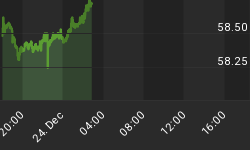Determining your risk footprint as an active market participant is as much an art form as a science these days. Cross currents can develop or reemerge that will make the best laid plans of mice and men go awry. The key ingredient is to do your homework and cover your exit angles.

Always the exit angles.
One of the few advantages of managing money in the short to intermediate time frames is the ability to quickly tact to a safe and protected berth if you sense conditions are about to change for the worse. Similar to sailing, you can anticipate troubled seas - but conditions can still spiral out of control faster than you can resolve them. It's always wise to loose some rigging, even a sail - if it get's you through the storm in one piece.
Continuing that train of thought, I'm still firmly in the camp that a lower low is upon us - it's just appraising where the market will likely pivot and if the benevolent and unyielding shoulder of the bull will once again emerge in tact.
While I don't think the US is headed for a recession on its own accord (although the politicians are certainly doing their best to point us that way), I can't rule out that the sovereign debt crisis in Europe won't spill over in the near term and metastasize with contagion tentacles to drag us to the edge of one ourselves. One analog that I have been carrying around in my files because of the similarities in price structure, market sentiment and macro condition, is 1998. A number of other parallels to 1998 are:
- The unbridled appetite for risk coming into 2011,
- The sovereign debt issues in Europe in 2010,
- The unwinding of a carry trade (yen) both in the beginning of the year and again today, and;
- The proportions and scale of the move in the gold/silver ratio
As a quick reminder, 1998 was an articulated market environment with considerable strength and momentum in the first third of the year, followed by extreme volatility and rapid market declines in the summer - culminating with a staggering year end rally. Throughout the year evidence continued to surface of persistent concerns about the Russian banking and financial sectors - culminating with the suspension of payment on sovereign debt issues and the float of the rouble in August of that year. The events were set in motion the previous year by the Asian currency crisis in 1997.
It sounds vaguely familiar to Europe's issues today, except that the European crisis has been contained within the EU itself. I believe to some extent this dynamic will continue to insulate the US markets from the extreme effects of the crisis abroad - although I'm sure there were many that believed the same thing until Long Term Capital Management brought the crisis home to our markets.
And while the players this time speak in the romanic tongues of Berlusconi persuasion instead of the slavic harsh tones of the Motherland - the reverberations and artifacts of a dislocation are present in the charts just the same.
Here is a long term (monthly) chart of the gold/silver ratio with the SPX overlaid for perspective.

This is a weekly chart contrasting the two time periods through the SPX and the VIX. The equity declines in 1998 were extreme in the US market because of the trojan horse that became LTCM.

If and when the June lows are broken, I believe the next level of support will be found around 1220. Assuming it holds, the remainder of the year will depend upon whatever fallout becomes of the European debt crisis and whether the economic soft patch we are currently walking in becomes more of a swampy liquidity trap.
Call me crazy, but I'm still cautiously optimistic the year will end on dry ground and firmly in positive territory.

I just joined Twitter. All my trades and occasional market musings are disclosed in real-time here.















